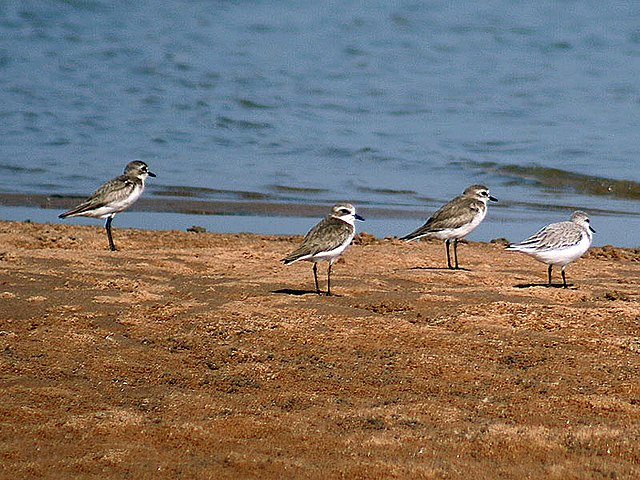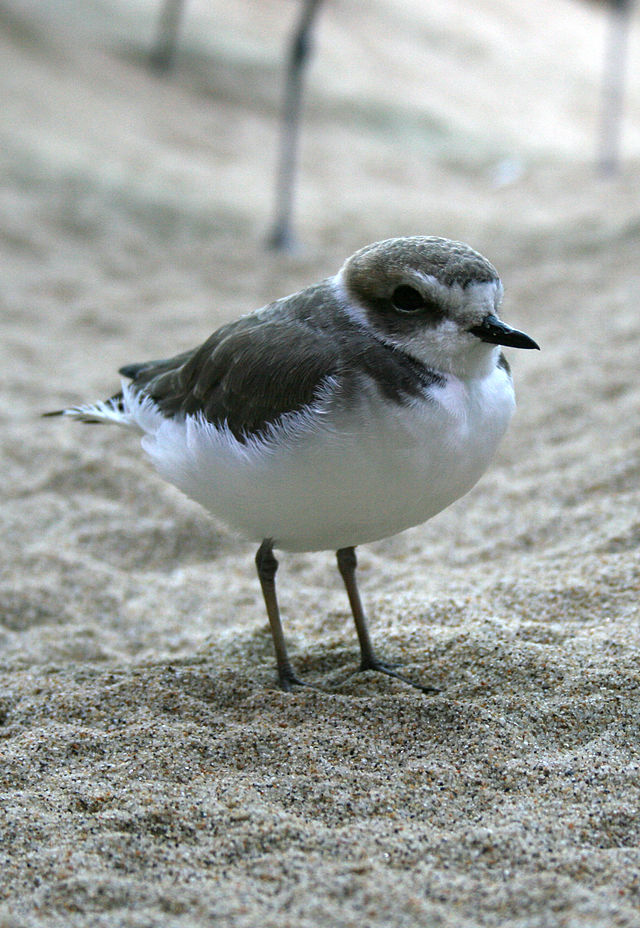Plovers (/ˈplʌvər/ PLUV-ər,[1] also US: /ˈploʊvər/ PLOH-vər)[2] are members of a widely distributed group of wading birds of family Charadriidae. The term "plover" applies to all the members of the family,[1] though only about half of them include it in their name.[1]
| Plovers | |
|---|---|
 | |
| Hooded dotterel (Charadrius cucullatus) | |
| Scientific classification | |
| Domain: | Eukaryota |
| Kingdom: | Animalia |
| Phylum: | Chordata |
| Class: | Aves |
| Order: | Charadriiformes |
| Family: | Charadriidae |
| Subfamily: | Charadriinae Leach, 1820 |
| Genera | |
|
see the table | |




Species list in taxonomic sequence
The taxonomy of family Charadriidae is unsettled. At various times the plovers, dotterels, and lapwings of family Charadriidae have been distributed among several subfamilies, with Charadriinae including most of the species. The International Ornithological Congress (IOC) and the Clements taxonomy do not assign species to subfamilies.[3][4] The South American Classification Committee of the American Ornithological Society (AOS) includes all of the species in Charadriinae.[5] The North American Classification Committee of the AOS and BirdLife International's Handbook of the Birds of the World separate the four members of genus Pluvialis as subfamily Pluvialinae.[6][7][8]
The IOC recognizes these 69 species of plovers, dotterels, and lapwings in family Charadriidae. They are distributed among 11 genera, some of which have only one species. This list is presented according to the IOC taxonomic sequence and can also be sorted alphabetically by common name and binomial.[3]
| Common name | Binomial name + authority | IOC sequence |
|---|---|---|
| Grey plover | Pluvialis squatarola (Linnaeus, 1758) | 1 |
| European golden plover | Pluvialis apricaria (Linnaeus, 1758) | 2 |
| Pacific golden plover | Pluvialis fulva (Gmelin, JF, 1789) | 3 |
| American golden plover | Pluvialis dominica (Müller, PLS, 1776) | 4 |
| Tawny-throated dotterel | Oreopholus ruficollis (Wagler, 1829) | 5 |
| Rufous-chested dotterel | Zonibyx modestus Lichtenstein, MHC, 1823 | 6 |
| Diademed sandpiper-plover | Phegornis mitchellii (Fraser, 1845) | 7 |
| Eurasian dotterel | Eudromias morinellus Linnaeus, 1758 | 8 |
| Killdeer | Charadrius vociferus Linnaeus, 1758 | 9 |
| Common ringed plover | Charadrius hiaticula Linnaeus, 1758 | 10 |
| Semipalmated plover | Charadrius semipalmatus Bonaparte, 1825 | 11 |
| Piping plover | Charadrius melodus Ord, 1824 | 12 |
| Hooded dotterel | Charadrius cucullatus (Vieillot, 1818) | 13 |
| Forbes's plover | Charadrius forbesi (Shelley, 1883) | 14 |
| Three-banded plover | Charadrius tricollaris Vieillot, 1818 | 15 |
| Black-fronted dotterel | Charadrius melanops (Vieillot, 1818) | 16 |
| Shore plover | Charadrius novaeseelandiae (Gmelin, JF, 1789) | 17 |
| Little ringed plover | Charadrius dubius Scopoli, 1786 | 18 |
| Long-billed plover | Charadrius placidus Gray, JE & Gray, GR, 1863 | 19 |
| Pied plover | Hoploxypterus cayanus (Latham, 1790) | 20 |
| Northern lapwing | Vanellus vanellus (Linnaeus, 1758) | 21 |
| Long-toed lapwing | Vanellus crassirostris (Hartlaub, 1855) | 22 |
| Blacksmith lapwing | Vanellus armatus (Burchell, 1822) | 23 |
| Spur-winged lapwing | Vanellus spinosus (Linnaeus, 1758) | 24 |
| River lapwing | Vanellus duvaucelii (Lesson, RP, 1826) | 25 |
| Yellow-wattled lapwing | Vanellus malabaricus (Boddaert, 1783) | 26 |
| Black-headed lapwing | Vanellus tectus (Boddaert, 1783) | 27 |
| White-crowned lapwing | Vanellus albiceps Gould, 1834 | 28 |
| Senegal lapwing | Vanellus lugubris (Lesson, RP, 1826) | 29 |
| Black-winged lapwing | Vanellus melanopterus (Cretzschmar, 1829) | 30 |
| Crowned lapwing | Vanellus coronatus (Boddaert, 1783) | 31 |
| African wattled lapwing | Vanellus senegallus (Linnaeus, 1766) | 32 |
| Spot-breasted lapwing | Vanellus melanocephalus (Rüppell, 1845) | 33 |
| Brown-chested lapwing | Vanellus superciliosus (Reichenow, 1886) | 34 |
| Grey-headed lapwing | Vanellus cinereus (Blyth, 1842) | 35 |
| Red-wattled lapwing | Vanellus indicus (Boddaert, 1783) | 36 |
| Javan lapwing | Vanellus macropterus (Wagler, 1827) | 37 |
| Banded lapwing | Vanellus tricolor (Vieillot, 1818) | 38 |
| Masked lapwing | Vanellus miles (Boddaert, 1783) | 39 |
| Sociable lapwing | Vanellus gregarius (Pallas, 1771) | 40 |
| White-tailed lapwing | Vanellus leucurus (Lichtenstein, MHC, 1823) | 41 |
| Southern lapwing | Vanellus chilensis (Molina, 1782) | 42 |
| Andean lapwing | Vanellus resplendens (Tschudi, 1843) | 43 |
| Red-kneed dotterel | Erythrogonys cinctus Gould, 1838 | 44 |
| Inland dotterel | Peltohyas australis (Gould, 1841) | 45 |
| Caspian plover | Anarhynchus asiaticus Pallas, 1773 | 46 |
| Oriental plover | Anarhynchus veredus Gould, 1848 | 47 |
| Tibetan sand plover | Anarhynchus atrifons (Wagler, 1829) | 48 |
| Siberian sand plover | Anarhynchus mongolus Pallas, 1776 | 49 |
| Greater sand plover | Anarhynchus leschenaultii Lesson, RP, 1826 | 50 |
| Double-banded plover | Anarhynchus bicinctus Jardine & Selby, 1827 | 51 |
| Wrybill | Anarhynchus frontalis Quoy & Gaimard, 1832 | 52 |
| New Zealand plover | Anarhynchus obscurus Gmelin, JF, 1789 | 53 |
| Wilson's plover | Anarhynchus wilsonia Ord, 1814 | 543 |
| Collared plover | Anarhynchus collaris Vieillot, 1818 | 55 |
| Mountain plover | Anarhynchus montanus Townsend, JK, 1837 | 56 |
| Puna plover | Anarhynchus alticola (Berlepsch & Stolzmann, 1902) | 57 |
| Two-banded plover | Anarhynchus falklandicus Latham, 1790 | 58 |
| Madagascar plover | Anarhynchus thoracicus (Richmond, 1896) | 59 |
| Kittlitz's plover | Anarhynchus pecuarius Temminck, 1823 | 60 |
| St. Helena plover | Anarhynchus sanctaehelenae (Harting, 1873) | 61 |
| Red-capped plover | Anarhynchus ruficapillus Temminck, 1821 | 62 |
| Snowy plover | Anarhynchus nivosus (Cassin, 1858) | 63 |
| Chestnut-banded plover | Anarhynchus pallidus Strickland, 1853 | 64 |
| Malaysian plover | Anarhynchus peronii Schlegel, 1865 | 65 |
| White-fronted plover | Anarhynchus marginatus Vieillot, 1818 | 66 |
| Javan plover | Anarhynchus javanicus Chasen, 1938 | 67 |
| Kentish plover | Anarhynchus alexandrinus Linnaeus, 1758 | 68 |
| White-faced plover | Anarhynchus dealbatus (Swinhoe, 1870) | 69 |
Description
Plovers are found throughout the world, with the exception of the Sahara and the polar regions, and are characterised by relatively short bills. They hunt by sight, rather than by feel as longer-billed waders like snipes do. They feed mainly on insects, worms or other invertebrates, depending on the habitat, which are obtained by a run-and-pause technique, rather than the steady probing of some other wader groups.[9] Plovers engage in false brooding, a type of distraction display. Examples include pretending to change position or to sit on an imaginary nest site.
In folklore
The European golden plover[10] spends summers in Iceland, and in Icelandic folklore, the appearance of the first plover in the country means that spring has arrived. The Icelandic media always covers the first plover sighting.[11]
See also
References
Wikiwand in your browser!
Seamless Wikipedia browsing. On steroids.
Every time you click a link to Wikipedia, Wiktionary or Wikiquote in your browser's search results, it will show the modern Wikiwand interface.
Wikiwand extension is a five stars, simple, with minimum permission required to keep your browsing private, safe and transparent.
